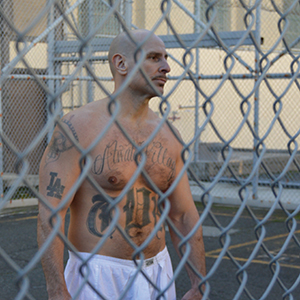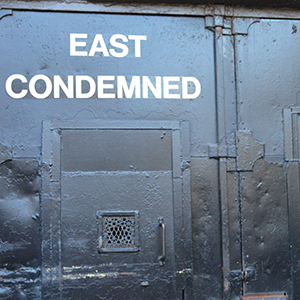Features & Columns
 FACE TIME: Adjustment Center inmates can earn the privilege to mingle with other inmates.
FACE TIME: Adjustment Center inmates can earn the privilege to mingle with other inmates.
Hunger to Live
Disembodied voices—harsh, angry and demanding—greet reporters as we spill into the vast East Block, home to the majority of the 724 condemned of San Quentin. There are more than 500 men here, and they shout down from the upper tiers, "They got us in restraints like we are animals!" "We want to come out of the handcuffs!"
They shout about spoiled milk and the endless pancakes for breakfast and about Burton Abbott, exonerated but nevertheless executed in 1955, from this intensely intimidating, five-tier stack of cells. American flags hang from sky-high rafters in both wings of East Block, and guards walk the gangway as reporters are set loose on the tier to find inmates to interview.
I walk down the tier and stop in front of the one inmate I had hoped to encounter today, Jarvis Jay Masters, the Buddhist author of 2009's That Bird Has My Wings. It's a heavy story about Masters' upbringing and his path to death row, with harrowing-funny stories about the violence of life among the condemned and Masters' journey to a monklike and meditative existence on death row.
Masters had just recently ended a 27-day hunger strike prompted, he says, by a chronic absence of capital crime lawyers at the prison. He ended up weakened and ill and on an IV at Marin General Hospital, and only ended the hunger strike when the warden came to see him.
"Guys are dying and nobody is up here saying, 'You are a human being,' Masters says. "Nobody says, 'Tell me your story.' The lawyers don't even know their clients' names, their stories, their suffering. It felt like there was a purpose behind the hunger strike. It helped me to understand suffering."
Masters is at work on his third book (he also published Finding Freedom, a collection of prison writings, in 1997). This one is going to be called Out of Bounds, a fictionalized retelling of his early 1970s childhood, he says, that will explore the abuse and molestation he experienced as a youth. "Out of Bounds" is the single most prevalent stenciled signage on the walls of San Quentin. The signs inform inmates that they've entered a restricted area.
Masters, a native of Long Beach, shuffled in and out of foster care homes as a child, which led him to a life of violent crime as a young man. He spent 21 years in the Adjustment Center, and turned to Buddhism and meditation to help survive the intense psychological strain of long-term solitary confinement. He has a dedicated support network on the outside that includes renowned Buddhist author Pema Chödrön, and a legal team at work to get his conviction overturned.
Some inmates, Masters says, have come to a kind of peace on death row; they've outgrown their criminality, but it can leave them in an awful and hopeless limbo. "Some people have made the transition," he says, "but there are more suicides than executions here."
Masters' Buddhist practice and meditation have kept him grounded in the face of a death sentence handed down after he was implicated in the 1985 murder of prison sergeant Howell Burchfield. There are all kinds of ways to torture yourself on death row, which include dwelling on "the contradictions in your life," Masters says, "the callings that you will think about for the rest of your life." Whether an inmate is innocent or guilty, "death row means you are in a lot of trouble, and you sit with that—my writing, that is how and where I found my greatest reflection of that fact."
Masters, 52, was sent to San Quentin in the early 1980s to serve a 10-year armed robbery sentence and then joined a prison gang. A few years into his term, he was implicated in the death of Burchfield and charged with sharpening a piece of bed frame into a shank, which was then fashioned into a spear, using rolled-up paper. Two other inmates were given life sentences without parole for their roles in the murder; Masters got the death penalty.
I ask him about his writing process, and Masters enthusiastically pulls out a white five-gallon bucket from the back of his cell. That's his writing chair. A large board propped on his rack serves as his desk. Then he shows me his pen.
When he was in the Adjustment Center, Masters' writing implement consisted of a floppy pen tube sans its plastic outer shell. He's been in the East Block since 2007 and takes apart the pen and shows me how it used to be. He gets a regular pen here.
Masters laughs as he shows me the other key piece of his writing kit, a tan crocheted hat. "Don't tell anyone, but I need my writing hat. I can't write without it."
Masters' many supporters are adamant that he is innocent of the capital charge that landed him on death row, and with a positive ruling from the California State Supreme Court he may find himself in a whole new situation by February.
In the meantime, there's a lot of old-fashioned Buddhism non-attachment that has to be brought to bear on the outcome. On Nov. 15, the court heard oral arguments from his defense team and from prosecutors.
"The case is still alive," Masters says. The clock is ticking on the court's 90-day window to issue a ruling. He could be looking at a new trial, or more of the same.
"Life changes one way or the other," Masters says. "One thing I have to do is be in the center; that's where my practice is. Being in the cell, it is so small and you get pulled—it is scary. You feel you are being pulled one way and then you are pulled the other way—the fear of wanting to stay in, the fear to get out—and so it is just so powerful to stay in the center."
 DO NOT ENTER: Lt. Sam Robinson stands before the entrance to East Block, where most of San Quentin's 724 condemned men live.
DO NOT ENTER: Lt. Sam Robinson stands before the entrance to East Block, where most of San Quentin's 724 condemned men live.
The Anti-Celebrity
The last full-on media tour of San Quentin's death row, Robinson says, was given around the time Scott Peterson was in the news as international anti-celebrity du jour. Interest was high. Peterson was universally reviled for killing his eight-months-pregnant wife and saying he was on a fishing trip in San Francisco Bay.
The TV cameras haven't been in here since his conviction, but San Francisco KALW radio reporter and author Nancy Mullane was given access to death row for a series of reports she produced between 2012 and 2014, and which culminated in the book Life After Murder, which wasn't about death row, but rather five inmates who Mullane believed deserved a chance at parole.
When the book came out, Mullane was invited on The Today Show, co-hosted by Matt Lauer. The interview was a revolting exercise in the media's anti-celebrity obsession, and it's clear from the segment that Mullane never would have been invited on the show had she not inadvertently captured Peterson in some photos she took on the North Seg rooftop yard. She didn't even know it was Peterson she was shooting, but one of the photos captured him smiling and shirtless, playing basketball.
We are up on the North Seg rooftop yard and, wouldn't you know, there's Peterson with his back turned to reporters. He and another man, an African American of less anti-celebrity stature, stand that way the whole time reporters interview other inmates. The condemned of North Seg are granted tier time to mingle with inmates, and they can spend several hours a day, from 7:30am to 1pm, in the rooftop yard, with its stunning views of San Francisco.
There's sheet metal fencing around the yard, which the warden says is there mostly to protect the privacy of inmates from binocular-wielding gawkers—another of the many contrasts within San Quentin: Where there's no privacy among and within the condemned, there's an effort to shield them from the eyes of a prying public.
This anti-celebrity dynamic is in the air all day long, and we the media play into it. There is a peculiar thrill being so close to the condemned, especially when some of them are so totally irredeemable. But the anti-celebrity media scrum did feel a little unseemly.
Serial killers occupy a peculiar social strata in the American imagination, as do upstanding citizens who who commit shockingly heinous crimes like Peterson—it's the last thing you'd expect of them. So Peterson turned his back, but Steven Livaditis availed himself to reporters on the rooftop yard. Livaditis killed three people during a 1986 jewelry store robbery in Beverly Hills and almost immediately admitted to his crime. He's been in the North Seg unit for almost 30 years. His death row days consist of reading the Bible and trying to "live the life of a good Christian," he says. "I have tried to make amends with the families."
Does God want him here? "Good question."
Quiet Time
The tour is a big production for the prison, and there are many moving parts—both at San Quentin and around the politics of capital punishment. Beyond the expansion of its death-row facilities, in October the prison marked the first anniversary of its court-mandated and first-in-the-nation Psychiatric Inpatient Program (PIP).
The 40-bed facility was built at a cost of $620,000 to address the stark reality that numerous men have been driven completely insane during their decades of limbo on death row.
Our prison guides show us the inside of the group therapy rooms that comprise part of the treatment, and once again, wherever the condemned of San Quentin go, whatever their mental health status, they are held in cages. Each of the small holding cells has a steel stool.
This unit feels peaceful in much the same way the Adjustment Center has an eerie sense of calm. One inmate stands at a big window looking out with his hands behind his back. The rooms are larger here, and there's a dictionary and a board game or two on a shelf.
The state is getting its death house in order for whatever might come next. It was recently announced that a new single-drug execution protocol—a lethal dose of barbiturate—will be administered to the condemned, amid a national focus on lethal injections that have gone awry because of multi-drug cocktails, and questions about the medical ethics of killing the condemned.
Enter the Sepulchral
The key has arrived and the guards open the door, and just like that, we're in there, the state's new, untested lethal injection facility. It's a bare, two-room chamber, save for 12 chairs and a gurney containing numerous black straps. A big clear window separates the chairs from the gurney. This is the only part of the tour where cameras are banned, as though we're going to steal a soul by taking a photo of the deathbed.
Again, I find myself taken by how a facility associated with such violence can have such a strangely peaceful and sepulchral elegance to it, this clean, austere chamber of death, deliverer of the haunted and broken and malevolent.


